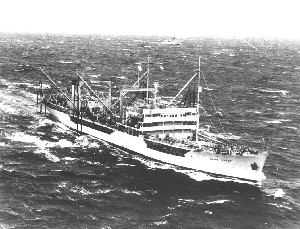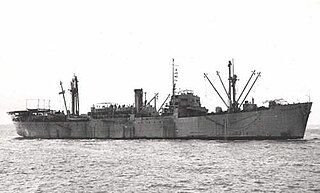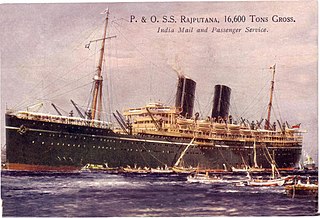
RFA Argus is a ship of the Royal Fleet Auxiliary operated by the Ministry of Defence under the Blue Ensign. Italian-built, Argus was formerly the container ship MVContender Bezant. The ship was requisitioned in 1982 for service in the Falklands War and purchased outright in 1984 for a four-year conversion to an Aviation Training Ship, replacing RFA Engadine. In 1991, during the Gulf War, she was fitted with an extensive and fully functional hospital to assume the additional role of Primary Casualty Receiving Ship. In 2009, the PCRS role became the ship's primary function. Argus is due to remain in service beyond 2030. In July 2022 it was reported that the future Littoral Strike Role would be assumed by Argus after a refit to convert her to this role. As of October 2023, Argus had started her deployment to serve as part of Littoral Response Group (South) based out of the UK Joint Logistics Support Base in Oman.

RFA Fort Austin is a retired British Fort Rosalie-class dry stores ship of the Royal Fleet Auxiliary.

RFA Fort Victoria is a Fort-class combined fleet stores ship and tanker of the Royal Fleet Auxiliary of the United Kingdom tasked with providing ammunition, fuel, food and other supplies to Royal Navy vessels around the world. She is now the only member of her class.

RFA Wave King (A182) was a Wave-class fleet support tanker of the Royal Fleet Auxiliary built at Govan by Harland & Wolff Ltd. In 1945, she served in the Far East with the British Pacific Fleet, designated Task Force 57 upon joining the United States fleet. On 6 May 1945 Wave King and Wave Monarch were with the Logistic Support Group 300 miles south-east of Miyako to refuel Task Force 57 which was launching air strikes against island targets in the Okinawa campaign.

RFA Wave Chief was a Wave-class fleet support tanker of the Royal Fleet Auxiliary that was built in 1946 as SS Empire Edgehil by Harland & Wolff, Govan, Glasgow, United Kingdom.

RFA Fort Duquesne (A229) was an air stores ship of the Royal Fleet Auxiliary a Fort type ship.

RFA Black Ranger (A163) was a British diesel-powered Ranger-class fleet support tanker of the Royal Fleet Auxiliary, built by Harland & Wolff at their yard in Govan. On 27 February 1941, shortly after her commissioning, she was involved in a collision with the French destroyer Mistral which sustained minor damage and Black Ranger spent a short period under repair on the Clyde.

RFA Resource was an armament stores ship of the Royal Fleet Auxiliary.

HMS Charybdis (F75) was a Leander-class frigate of the Royal Navy (RN). She was built by the Harland & Wolff company of Belfast, and was the last ship to be built there for British naval forces until RFA Fort Victoria of the Royal Fleet Auxiliary, was launched in 1990. Charybdis was launched on 28 February 1968 and commissioned on 2 June 1969. Her nickname was "Cherry B".

The Fort Victoria or Fort II class is a class of replenishment oiler of the Royal Fleet Auxiliary, a role that combines the missions of a tanker and stores supply ship. As such they are designated auxiliary oiler replenisher (AOR). They are tasked with providing ammunition, fuel, food and other supplies to Royal Navy vessels around the world. There were two ships in the class, Fort Victoria and Fort George; the latter being taken out of service and despatched for scrapping at a Turkish breakers as a consequence of budgetary cutbacks.

HMS Queen Emma was a commando troop ship of the Royal Navy during the Second World War. Built as a civilian passenger liner in 1939 by De Schelde at Vlissingen, she was named the MS Koningin Emma, after Queen Emma of the Netherlands, and operated by Stoomvaart Maatschappij Zeeland (SMZ) between Flushing and Harwich, along with her sister ship, MS Prinses Beatrix. After fleeing to Britain after the German invasion in 1940, she was requisitioned by the British Ministry of War Transport, renamed HMS Queen Emma and converted to a troopship at Harland and Wolff's yard in Belfast. During the war her main role was transporting British Commandos, and she participated in the Lofoten Islands Raid and the Dieppe Raid. She had the advantage of a high speed that allowed hit and run operations. Later designated as a Landing Ship, Infantry (Medium) she took part in the landings in North Africa, Sicily and Normandy. She operated in the Indian Ocean, and in the Dutch East Indies after the end of the war. In 1946 Queen Emma was returned to her owners and continued to operate as ferry from the Hook of Holland until 1969, when she was scrapped in Antwerp, Belgium.

HMS Endurance was a Royal Navy ice patrol vessel that served from 1967 to 1991. She came to public notice when she was involved in the Falklands War of 1982. The final surrender of the war, in the South Sandwich Islands, took place aboard Endurance.

SS Rajputana was a British passenger and cargo carrying ocean liner. She was built for the Peninsular & Oriental Steam Navigation Company at the Harland and Wolff shipyard at Greenock on the lower River Clyde, Scotland in 1925. She was one of the P&O R-class liners from 1925 that had much of their interiors designed by Lord Inchcape's daughter Elsie Mackay. Named after the Rajputana region of western India, she sailed on a regular route between England and British India.
HMS St Austell Bay was a Bay-class anti-aircraft frigate of the British Royal Navy, named after St Austell Bay on the south coast of Cornwall. In commission from 1945 until 1956, she served in the Mediterranean Fleet and on the America and West Indies Squadron.
HMS Tremadoc Bay was a Bay-class anti-aircraft frigate of the British Royal Navy, named for Tremadoc Bay in north Wales.

RMMV Capetown Castle was a British passenger liner built by Harland & Wolff at Belfast for the Union-Castle Line's mail service from Southampton to South Africa. She was launched in September 1937 and sailed on her maiden voyage on 29 April 1938.
Empire Bede was a 6,959 GRT cargo ship which was built by G M Harland & Wolff Ltd, Glasgow in 1942 for the Ministry of War Transport (MoWT). She had a short career, being damaged by a torpedo and then sunk by gunfire on 18 August 1942.

SS Athenic was a British passenger liner built by Harland & Wolff shipyards for the White Star Line in 1901.
Stirlingshire was a 7,067 GRT refrigerated cargo liner that was built in 1944 by Harland & Wolff Ltd, Belfast, United Kingdom as Empire Falkland for the Ministry of War Transport (MoWT. She was sold into merchant service in 1946 and renamed Stirlingshire. She served until 1966, when she was scrapped.

The bombing of RFA Fort Victoria took place on 6 September 1990, when a unit of the Provisional Irish Republican Army (IRA) planted two bombs aboard the Royal Fleet Auxiliary replenishment ship at Harland and Wolff shipyard in Belfast, Northern Ireland, where the vessel had been launched four months before. One of them exploded in the engine room, causing flooding and serious damage. The second device didn't explode and was defused several days later. The attack resulted in a two-year delay before Fort Victoria became fully operational.
















